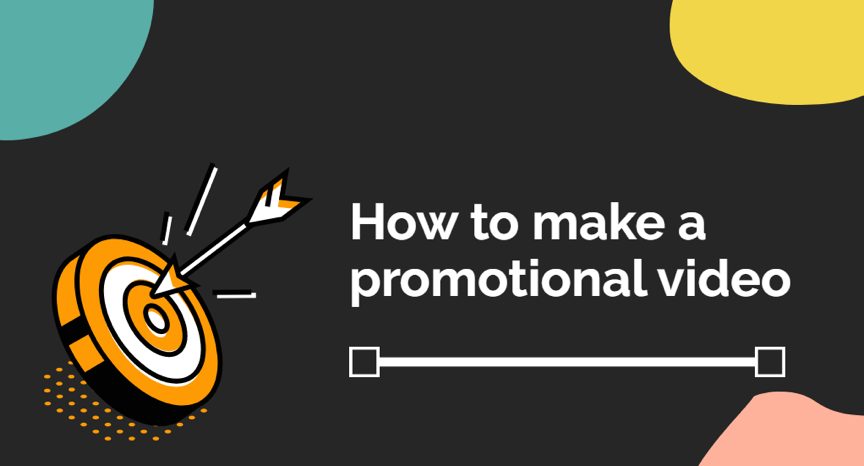The promotional video will allow us to advertise a product, a brand, a service or educate the consumer before the sale. To make a good promotional video, we will have to take into account several factors, which we will cover in this post. Shall we start? From setting the goal to choosing the visual style, you can get a quality promotional video with tips below.
Set your goal
Before you start thinking about recording or starting with the production of the video, it will be very important that you define the objective for which you are determined to carry out this advertising action. Ask yourself the reasons why you want to make a promotional video. What do you hope to get out of it specifically? The more specific you are, the better. A video is not one of the exactly cheap advertising actions, so you have to be very clear about this first point. Some common reasons when creating a promotional video:
- Brand recognition
- Sales increase
- Attract visitors to your website
- Build customer loyalty
- Educate the consumer
- Promote a product or service
For example, let’s imagine that your brand has just hit the market and you want the public to start getting to know you and become familiar with you. In that case, the goal would be to make a brand recognition video.
It may be that your objective is not unique and therefore, they are multiple. Be careful since the more objectives you want to obtain from a single video, the more difficult it will be to communicate effectively to your target. Ideally, you would create a video dedicated to achieving a single goal and, if you have more goals in mind, make specific videos for each of them. In any case, if you want to set more than one goal, try not to have more than two goals per video.
Define the video type
Once the objective is defined, we will have to think about the approach that we will give to the video. For example, if we have a website that offers a service, it would be perfect to create an explanatory video to convey to the visitor what they can expect from the service you want to promote. It would also be a very valid option to use a video of the problem/solution type. Some possible approaches for a promotional video:
- Introductory: explain to your audience who you are and what you do
- Explanatory: explains how a service/product/website works
- Problem/Solution: clearly show the problem and how your product or service solves it
- Narrative: use elements such as a plot with a conflict and its resolution to explain in an implicit way how your product or service solves it
- Call to action: urge the audience to take action, for example: get your discount now
- Product focused: promote a product or series of products directly
- Testimonial: interviews, citations, audios of satisfied clients
- Proof of value: use a media person to talk about your service or product
- Informative: educate your audience on how to do something specific, for example, a video tutorial
- Entertaining: use a more relaxed and even fun format to entertain your audience
Determine the tone
We understand the language that the video should use and what we want the audience to feel when they see it with tone. It may be that you want your audience to have fun watching the video, to be moved by an exciting story, to have a purely informative tone, to feel the urgency, etc.
Keeping the previous two points in mind will help us determine the tone with which we will have to work the video. We must also consider the type of audience we are targeting and the profile of our potential client. Some tones for a promotional video:
- Dramatic: get to the emotional side
- Direct/informative: clear and concise
- Urgent: urge action
- Fun: use a funny and close language
- Humorous: use wit and humor to connect with the audience
Set the duration
To determine the duration of the video, we must consider several factors, such as those described above, but above all, what is most relevant when deciding the duration of a promotional video is the platform or medium where it will appear.
For example, on television, advertisements do not usually last more than 1 minute, so it would be best to make a video of approximately 30 seconds in this case. If, on the other hand, we plan to carry out an advertising campaign through social networks and specifically speaking of Facebook, promotional videos usually last from 5 to 15 seconds, although the maximum allowed is 31 seconds. We must also bear in mind that the longer the video is, the more expensive it will be.
Another important aspect is that if we make an extremely long video, we will risk our audience being dispersed among so much content. So the goal we have set for the video will be diluted and will not be as effective as we want.
It is important to be clear about this point and set a maximum duration. Across the different platforms and media, you’ll have to start trimming it and it won’t be exactly mentally easy to get rid of portions of the video. You can also choose to make several adaptations with different durations to have more flexibility when choosing one version or another according to each particular case.
Choose a specific graphy or visual style
After defining the series of previous points, we move on to the style of the video that we will choose to apply.
- Animated: it can be in both 2d and 3d. The idea is that it is animated
- Real people: using real actors to interpret the script
- Stock video: a stock video is a video that is available to buy in a video bank. It is a much cheaper option
- Screen: a recording of a computer screen or any device interacting for explanatory purposes
- Whiteboard: a whiteboard and markers, it is the only thing you need to write and draw what is explained in the audio
Some videos contain elements of others, for example, real actors interacting with 3D animated characters, etc. The imagination has no limits, so you only have to explore. To decide what type of video you need, consider the previous steps and the budget you want to allocate.
If you have to hire actors and a whole professional recording team, it will be much more expensive than making an animated video in 2D. If you have very little budget, in that case, the best option for you would be to use a stock video, although obviously you will have to adapt the script to fit the stock video and at the same time, the stock video must fit with what you want to promote.
Write the script
This point will be very useful for us when we face writing the script. Defining the idea in writing of the aspects that we are going to cover in the script, using keywords that we want to appear in it, will be crucial to create a solid script later.
We can start with a very general idea of what we are going to deal with and develop. Once we have the idea defined, we can start writing the script. We must take into account all the points mentioned above, the tone, the focus, the duration … etc. Doing things right, you should create an outline with the following points:
- The scene number
- The moment in which the events happen (seconds/minutes)
- The dialogue in each moment (seconds/minutes)
- The description of the scene, the actors, expressions, feelings that each of them must show, etc.
Create a storyboard
The goal of the storyboard is to create a visual guide to the scenes to get a general idea of how the actors are to act. For the storyboard, we do not need a work of art, far from it, but if you do not have a good drawing hand, it will be necessary for you to work with an illustrator to help you capture what you have in mind.
In the storyboard, we will incorporate the script that we have previously created. In each scene, we will incorporate the corresponding writing. Having the storyboard and the dialogue, we can start creating the promotional video with some free or paid video ad makers.
To sum up
The promotional video is one of the most widespread methods and more advertising return. An audiovisual format is always attractive, considering that it requires the use of more than one sense. We’ve shared the tips and steps to make a promotional video. Now you can get started to make your first promotional video.




